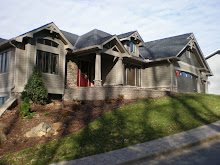Passive Solar Home Design
Your home's windows, walls, and floors can be designed to collect, store, and distribute solar energy in the form of heat in the winter and reject solar heat in the summer. This is called passive solar design or climatic design. Unlike active solar heating systems, passive solar design doesn't involve the use of mechanical and electrical devices, such as pumps, fans, or electrical controls to move the solar heat. Passive solar homes range from those heated almost entirely by the sun to those with south-facing windows that provide some fraction of the heating load. The difference between a passive solar home and a conventional home is design. The key is designing a passive solar home to best take advantage of your local climate.
The following five elements constitute a complete passive solar home design. Each performs a separate function, but all five must work together for the design to be successful.
Aperture (Collector)
The large glass (window) area through which sunlight enters the building. Typically, the aperture(s) should face within 30 degrees of true south and should not be shaded by other buildings or trees from 9 a.m. to 3 p.m. each day during the heating season.
Absorber
The hard, darkened surface of the storage element. This surface, which could be that of a masonry wall, floor, or partition (phase change material), or that of a water container, sits in the direct path of sunlight. Sunlight hits the surface and is absorbed as heat.
Thermal mass
The materials that retain or store the heat produced by sunlight. The difference between the absorber and thermal mass, although they often form the same wall or floor, is that the absorber is an exposed surface whereas thermal mass is the material below or behind that surface.
Distribution
The method by which solar heat circulates from the collection and storage points to different areas of the house. A strictly passive design will use the three natural heat transfer modes conduction, convection, and radiation, exclusively. In some applications, however, fans, ducts, and blowers may help with the distribution of heat through the house.
Control
Roof overhangs can be used to shade the aperture area during summer months. Other elements that control under- and/or overheating include electronic sensing devices, such as a differential thermostat that signals a fan to turn on; operable vents and dampers that allow or restrict heat flow; low-emissivity blinds; and awnings.
Advantage Development Co. is an Award Winning Green Home Custom Builder in Asheville NC building dreams since 1990. Call us today at 828.215.9064 for a free consultation or visit us at http://www.advdevco.com/ and learn why we build better homes in Asheville and the surrounding WNC area.
Subscribe to:
Post Comments (Atom)


No comments:
Post a Comment